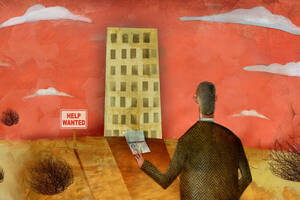Organizations Economics Policy Nov 1, 2021
What Businesses Must Do to Curtail Climate Change
We need to dramatically reduce carbon emissions. This will require a new system of incentives.

Yevgenia Nayberg
How long do we have to stop climate change?
If the question seems charged—scientifically, politically, and emotionally—that’s because it is. “This can be a frightening and depressing topic that people aren’t quite sure how to engage with,” says Meghan Busse, an associate professor of strategy at Kellogg and an expert in the economics of energy markets.
Which is not to say that the actual answer is in doubt: the science is quite clear.
“The Intergovernmental Panel on Climate Change published a report in August of this year and the answer … was a sobering one: We don’t have any time. We don’t have any time anymore,” says Busse.
That doesn’t mean that there is nothing to be done, or that our future is entirely out of our hands. In a recent webinar for The Insightful Leader Live, Busse explained what businesses and policymakers can—and must—do to put our economy and our world on a more sustainable path.
Some Additional Warming Is Already “Baked In”
To start, we need to accept a difficult reality. Thanks to the greenhouse gases we’ve already released into the atmosphere, our climate will continue to warm for decades.
“Even if we cut carbon emissions dramatically and immediately, we are already committed to a path of increasing temperature,” says Busse. This means that glaciers and permafrost will continue to melt, and oceans will continue to warm, acidify, and lose oxygen. Sea levels will rise.
Still, our actions today could mean the difference between bad outcomes and disastrous ones. We know that the “normal” that the last summer represented, with its record-breaking flooding, wildfires, heatwaves, and hurricanes, will get worse. The choice now? “Do we want that worsening to be a little bit worse, or do we want it to be a lot worse?” says Busse.
3 “Levers” to Pull
Busse explains that the bulk of our greenhouse gases come from electricity generation, transportation, and industrial and agricultural use—giving us three “levers” we can pull to decrease global emissions.
So how effectively are we pulling these levers at the moment?
- Regarding electricity, Busse had genuinely positive news to share: “The cost of renewable energy has fallen dramatically faster than anybody expected a decade ago,” she says. “We expected it would take us 50 to 100 years to have the cost of generating electricity fall as much as it has.”
In fact, with some renewable energies such as wind and centralized solar, “we’re starting to get to the point where it is cheaper to install new renewables than it is to run existing fossil-fuel generation,” she says. Where we need to continue to invest is in less expensive and more efficient long-term battery storage. We will also need to update our energy grids and find ways to bypass some of the entrenched political interests slowing down the transition to renewables. - Transportation represents a thornier technological challenge. While there has been some momentum in the transition to greener passenger vehicles, “other transportation applications like freight trucking, like shipping and like travel by air are not nearly as easy to electrify,” says Busse. These modes of transportation require energy sources that are incredibly dense and portable. Continuing to develop new technologies such as “green hydrogen”—hydrogen that’s produced by electrolysis using renewable energy—will be necessary.
- The final lever, industry and agriculture, poses another tremendous challenge. The industries that produce the most greenhouse gases are those that are energy and heat-intensive, including those that use iron, steel, and cement. For agriculture, fertilizer production, methane production (from livestock) and deforestation are major emission concerns. “What holds us back is a lack of incentives,” says Busse. “The honest truth of the matter [is that] ultimately greenhouse-gas reduction mostly increases costs, mostly without creating what most customers feel is a tangible benefit.” That makes it hard for companies to do the right thing, particularly in the most competitive industries.
A “Mix of Carrots and Sticks”
Moving past these technological, political, and economic challenges will require a dramatic departure from the status quo.
Unfortunately, our actions as individuals—think recycling or taking public transportation—are unlikely to sufficiently move the needle. The bulk of decisions about carbon emissions are made inside companies, so businesses have a huge role to play in taking us to a carbon-neutral future.
For one, sustainability goals need to be integrated throughout organizations, rather than siloed into a single department or team. This will ensure that every meaningful decision is made with environmental concerns in mind. “Sustainability has to be everybody’s problem,” says Busse.
Institutional investors can also put pressure on companies to improve their carbon footprints, and large firms can pressure their suppliers. But these kinds of incentives are also unlikely to be enough.
“If companies respond to climate change only to the extent that it threatens their own profits, their own private incentives, then they’re not going to be doing enough. This is what we’ve been doing for the last 30 or 40 years,” says Busse.
This means that businesses also need to be clear and persistent in telling policymakers that all of us are better off if we can limit the rise in global temperature. Particularly, she advocates for a global carbon price, which would force the true costs of emitting carbon to be passed along to end users, such as customers. She also advocates for policies that support research and development into critical technologies such as battery storage and green hydrogen. And, since it will be hard to wean ourselves entirely off of carbon-intensive materials such as steel and cement, we may also need to invest in carbon-removal technologies.
Busse wants to see “a mix of carrots and sticks that will provide companies direct financial incentives to do not only what’s good for their own narrow and immediate interest, but what’s necessary for protecting the future.”
*
Editor’s note: Want to learn more? Watch the entire webinar. But also be sure to check out the extensive list of related reading, viewing, and listening, which Busse curated specifically for our audience. Delve into everything from the political challenges faced by nations around the world to just how economists would go about setting the price for carbon.
Jessica Love is editor in chief of Kellogg Insight.



